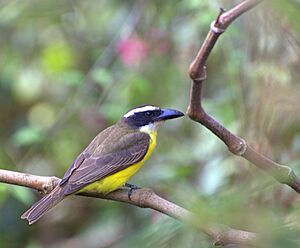Boat-billed flycatcher facts for kids
Quick facts for kids Boat-billed flycatcher |
|
|---|---|
 |
|
| Conservation status | |
| Scientific classification | |
| Genus: |
Megarynchus
|
| Species: |
pitangua
|
 |
|
| Synonyms | |
|
|
The boat-billed flycatcher (Megarynchus pitangua) is a cool passerine bird. It's a big type of tyrant flycatcher. This bird is the only one in its special group, called Megarynchus.
These birds make their homes in open woodlands. They like places with some tall trees. You can find them from Mexico all the way south to Bolivia and Argentina. They also live in Trinidad.
The female boat-billed flycatcher builds the nest. It looks like an open saucer made of sticks. She usually lays two or three whitish eggs. These eggs have brown spots. The female bird sits on the eggs for about 17 to 18 days. After the eggs hatch, the baby birds stay in the nest for about 24 more days. Then they are ready to fly!
What Does a Boat-billed Flycatcher Look Like?
Adult boat-billed flycatchers are quite large. They are one of the biggest tyrant flycatcher species. They grow to be about 23 cm (9.1 in) long. That's about the length of a ruler! They weigh around 70 g (2.5 oz).
Their head is black with a bright white stripe above their eyes. They also have a hidden yellow patch on top of their head. Their upper body is olive-brown. Their wings and tail are brown, with just a little bit of reddish-brown color on the edges. Their belly is yellow, and their throat is white.
The most special thing about them is their huge black bill. It looks like a boat, which is how they got their name! This big bill helps tell them apart from the great kiskadee. The great kiskadee also has more reddish-brown on its tail and wings. It also doesn't have the olive color on its upper body. The boat-billed flycatcher makes a loud, trilling sound. It sounds like nya, nya, nya.
What Do Boat-billed Flycatchers Eat?
Boat-billed flycatchers are clever hunters. They wait quietly on a hidden branch high in a tree. When they see an insect, they quickly fly out to catch it. They often catch insects like cicadas right in the air!
They also pick up invertebrates from leaves. Besides insects, they enjoy eating some berries. They like berries from plants called Cissus and Miconia. They also eat small wild figs. Sometimes, they eat dry green fruits from Cecropia trees.



